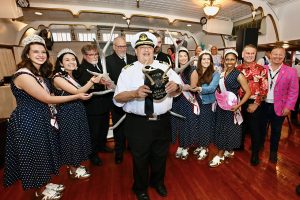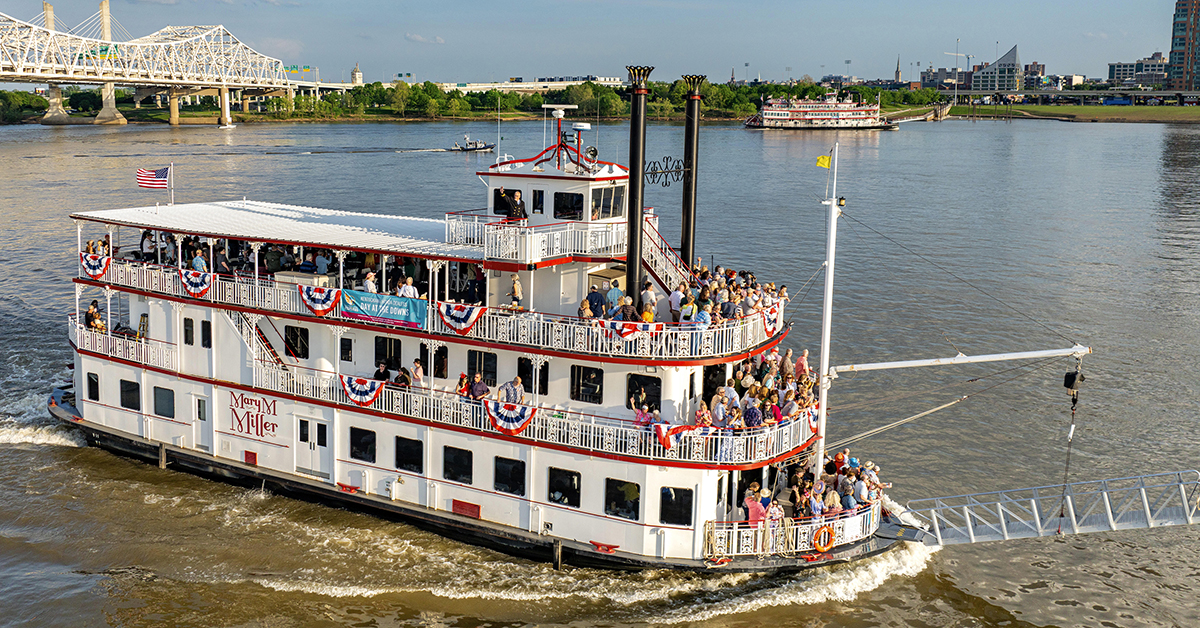The Great Steamboat Race has been an annual event at Louisville, Ky., for most of the past 62 years, and is usually held the Wednesday before the running of the Kentucky Derby. The races have seldom been mundane and usually provide some out-of-the-ordinary entertainment. This is how the tradition of the race came to be, some of the happenings through the years and details of the 2025 race.
The Jefferson County Fiscal Court, Louisville, with Judge Marlow Cook presiding, purchased at auction on May 24, 1962, the tramp excursion steamer Avalon and renamed it Belle of Louisville. The sale price was $34,000, and much criticism ensued over this expenditure for a “decrepit old steamboat.” That description, according to the late Alan L. Bates, who was hired to be the consulting architect during restoration of the boat, was pretty accurate. In his book “Belle of Louisville,” Bates tells of the sad shape the then 48-year-old steamboat was in when it was towed to Louisville in July 1962 and the months of hard work it took to bring it back to life.
As the work on the boat was somewhat nearing completion, a committee that had been formed to oversee the project felt confident enough to challenge the tourist steamer Delta Queen to a race. The Delta Queen, then the only overnight tourist boat on the Mississippi River system, had been built at Stockton, California, in 1926 for service on the Sacramento River. It was purchased by Greene Line Steamers of Cincinnati in 1947 and brought around to the Mississippi via the Panama Canal.
With the size and power difference between the two boats, the idea of a “race” was somewhat humorous on the surface. The Belle of Louisville had a hull size of 157 by 36 feet and had 400 hp. from engines that were 16’s – six-foot stroke, while the big Delta Queen was 250 by 58 feet and was rated 2,000 hp. with engines that were 26’s, 52 ½’s – 10-foot stroke. It was determined that this celebrated race would be a pre-Derby event, and the date selected was April 30, 1963. Capt. Ernest E. Wagner of the Delta Queen had long been master of the Belle when it was the Avalon, and Capt. Paul H. Underwood of the Belle had once been master of the Queen, so good-natured rivalry was ripe.

Bates says that the race day “dawned with drizzly skies and a bitter cold wind.” The river was somewhat swollen, and the Delta Queen sat slowly rolling her big sternwheel while waiting for the Belle to depart her landing. Finally, the smaller boat backed away, and right away things went wrong – the steering engine failed, and the pilot ultimately had to hand-steer the boat with the big pilot wheel for the duration of the day. As the race got underway, the firemen aboard the Belle struggled to maintain steam pressure as the fuel in the day tank was fouled with trash and water. The smoke emitting from the twin stacks was mixed with steam from the water-tainted fuel.
The well-publicized event drew huge crowds that lined the shores as the Delta Queen steadily drew away from the Belle of Louisville. The bigger boat rounded the turning buoy and passed the Belle as it was still upbound. To add insult to injury, the calliope on the Queen was playing “Goodbye, Little Girl, Goodbye” as they passed. The Belle finished three miles behind in a 12-mile race. In the end, the event was actually a huge success for both boats as the Belle of Louisville not only earned some $7,000 but also became wildly popular with the local citizenry. In turn, the Delta Queen sold out every cabin for every trip of the 1963 season.
A return bout was held in 1964 that drew throngs of spectators, and in this one the Belle of Louisville managed to eke out a victory. The annual race became a treasured part of the Derby week festivities, with the Delta Queen winning some of the contests and the Belle others and no set pattern. The 1967 race was canceled entirely due to high water, and in one instance in the early 1970s the Delta Queen was delayed and did not arrive in time for the race, with the plucky Belle running the course alone and claiming victory.
When the Delta Queen was fitted with a thruster that made it more maneuverable and allowed it to make the race turn faster, those on the Belle of Louisville cried foul because that boat was still as it had been built in 1914 with no “modern frills” to help it in turning. The next year they were ready when a local harbor boat darted out and assisted the Belle at the turn. When those with the Queen complained, the crew of the Belle replied that it was just their “bow thruster.” During another event, the Belle of Louisville made a sweeping turn and ran down behind Six Mile Island, the turning point. Antics such as these have served to make the race a fun time for all.
In 1975 and 1976, the two combatants were joined by a third steamboat, the Julia Belle Swain, which won the 1976 contest. In 1982, the graceful steamer Natchez (which had been designed by Alan Bates) of the port of New Orleans was at Louisville and participated in the race. The Natchez won handily that year, as her finely modeled hull cut the water so cleanly that she could have won with one boiler shut down. The diesel excursion boat Spirit of Jefferson ran in place of the Belle of Louisville one year after the steamboat suffered a partial sinking due to sabotage and was being repaired and refurbished.
In 2002, the Belle of Cincinnati, a diesel-powered excursion boat owned by BB Riverboats, began attending the Great Steamboat Race. It ran with the two steamboats that year, and Capt. Alan Bernstein, master and penultimate showman of the Belle of Cincinnati, claimed victory but was disqualified due to the diesel power of his vessel. This was only the beginning of Capt. Bernstein’s antics to be seen during future events.
2008 was the last time that the legendary Delta Queen participated in the Great Steamboat race as it was withdrawn from service after that. From that point on, the Belle of Cincinnati was the contender against the Belle of Louisville, with Capt. Bernstein usually adding comical elements to the day. The 2011 race was postponed until June due to high water, and the Belle of Cincinnati was temporarily renamed Belle of Kentucky, flying University of Kentucky flags and banners to make the race about the traditional rivalry between that school and the University of Louisville, since the Derby fever had passed.
The steamer American Queen raced against the two Belles in 2012, but the Belle of Louisville was the victor. In another race, the Belle of Cincinnati was declared the loser, and some members of the crew sought revenge as the boat was departing for home by swiping one of the famous Gallopalooza horse statues found around Louisville. The theft was soon discovered, and Capt. Bernstein received a call as he was driving back to Cincinnati that a warrant had been issued for his arrest in the matter. News crews met the boat as it arrived back in Cincinnati. Of course, it had all been done for fun (and publicity). The statue was returned, and Bernstein avoided jail time.
As the time drew near for the running of the 2025 Great Steamboat Race, the distressing news was shared that the beloved 111-year-old Belle of Louisville would not be able to run in it due to a small leak found in an internal bulkhead. Her ‘scape pipes would not be sounding like cannon fire as she ran full ahead, and the bright red sternwheel would be still instead of throwing spray high in the air. All was not lost as it was announced that the Mary M. Miller, a diesel excursion boat and companion vessel to the Belle of Louisville, would be running instead.
True to form, as soon as the Belle of Cincinnati arrived in town, Bernstein began his good-natured protests. He immediately declared his boat the winner as the race was to have been between the two Belles, and not including the Mary M. Miller. His outburst was ignored, and the race ran as scheduled on the evening of April 30. The Miller reportedly took an early lead, and catcalls and trash talk were exchanged between the two boats as they ran the 14-mile course. As the Mary M. Miller, in charge of Capt. Joe Kenney and piloted by Capt. Nicholas Lukaszewski, crossed the finish line first, Bernstein was still loudly proclaiming that his boat was the victor by the default of the Belle of Louisville.
At the award ceremony aboard the Belle of Louisville later, Bernstein jumped in to “photo-bomb” the pictures being taken as those from the Miller received the Silver Antlers passed to the winners of the race. He was still claiming victory but was overruled by the race judges. His outbursts were rewarded with a small set of antlers mounted to a plaque with the word “LOSER” emblazoned on it.
Some complain that this Derby Week staple is a predetermined “race.” In the end, it really doesn’t matter. The public and those involved enjoy it, and the well-publicized event highlights a portion of the river industry. In that respect, all are winners. It is hoped that the venerable Belle of Louisville is up and steaming soon and ready for avengement in the 2026 Great Steamboat Race.
The Belle of Cincinnati is a diesel excursion boat that is propelled by a sternwheel and twin propellers. It is 201 by 49.5 feet and is allowed 1,000 passengers. The boat was built in 1991 by Atlantic Marine, Inc., Jacksonville, Fla., as the casino boat Emerald Lady. It was originally in Bettendorf, Iowa, and then Biloxi, Miss., until it was sold in 1999 to BB Riverboats, Newport, Ky., which converted it into an excursion vessel and renamed it.
The Mary M. Miller is a twin-screw excursion boat that is 95 by 31 feet and allowed 600 passengers. It was built in 1985 by Marine Builders, Utica, Ind., just across the Ohio River from Louisville. Originally the Missouri River Queen at Kansas City, Mo. it was renamed Georgia Queen and operated out of Savannah, Ga. until sold to Waterfront Development Corp., Louisville in 2017 and renamed. The name honors Mary Millicent Miller, of the Portland section of Louisville who is credited as being the first woman to hold a steamboat master’s license, which was issued to her in 1884.
Featured photo caption: Capt Alan Bernstein of the Belle of Cincinnati accepts the “Loser Antlers” at the award ceremony following this year’s Great Steamboat Race. (Photo courtesy Terri Bernstein)



